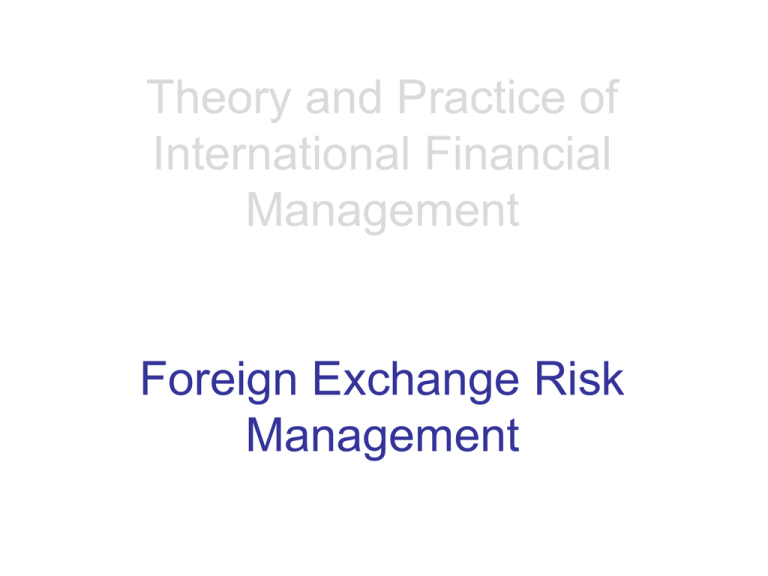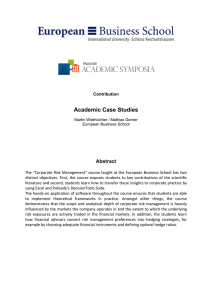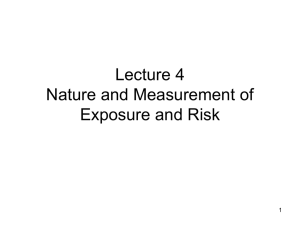Theory and Practice of International Financial Management Foreign Exchange Risk
advertisement

Theory and Practice of International Financial Management Foreign Exchange Risk Management Foreign exchange risk: meaning • Value of a currency changes frequently • Affects firms engaged in international transactions • Assets, liabilities and cash flows are affected through changes in exchange rates • Possibility of unfavourable changes - Risk Types of risk/ exposure • Accounting/ translation exposure: financial statements • Economic exposure: cash flows – Transaction exposure: present cash flows – Real operating exposure: future cash flows Translation exposure • Occurs on consolidation of financial statements of different units of MNCs • When the value of currency of a subsidiary changes, its translated value in the domestic currency of the parent company changes • This change represents translation exposure • It is only an accounting exposure Transaction exposure • Impact of exchange rate fluctuations on present cash flows • From transactions already entered into – Export and imort – Borrowing and lending in foreign currency – Intra firm fund flow in an international company Real operating exposure • Changes in exchange rates alter future operating revenues and cost streams of a company • Changes in future cash flows from changes in exchange rates - real operating exposure Foreign exchange risk: techniques of management • Transaction risk (short term): – Hedging using currency forwards or futures • Real operating risk (long term): – Adaptation in production and marketing strategy (plant location, input mixing, input sourcing, market selection, product planning, pricing, etc ) • Translation risk: accounting risk The Nature of Hedging We have: 1. Developed a number of measures of exposure 2. Constructed measures of the risks associated with these exposures 3. Determined how to identify the appropriate exposure to hedge among a portfolio of exposures. 4. Reviewed the advantages and disadvantages of a number of financial instruments that can aid us in hedging these exposures. The Nature of Hedging At this point, we want to address some broader concerns in foreign exchange risk management: 1. Why hedge? 2. What kinds of risks should we focus on to hedge? 3. At what horizon should the hedging take place? 4. What can be done from the operational side to manage foreign exchange risks? 5. What is an appropriate overall approach for managing foreign exchange risk at a multinational? Why Hedge? As we have seen, exposure alone does not justify hedging. However, the risk associated with a particular exposure may be sufficient to justify hedging. But this assumes that companies are risk-averse. When are companies risk-averse? This question must be addressed before a firm undertakes the costs associated with hedging foreign exchange risks. Why do corporations prefer a known home currency amount rather than a gamble with the same expected value involving potential gains or losses? What is the ultimate objective of the firm? To maximize shareholder value…and minimize systematic risks. Why Hedge? Relative to the amount of hedging that takes place, the arguments for firm risk-aversion are somewhat scarce. When will risk management improve shareholder wealth and/or reduce their systematic risk? 1. Tax gain/loss treatment asymmetry. 2. High financial distress costs. 3. Internal vs. external capital markets. 4. Executive compensation / monitoring / transparency. 5. Firms can hedge more efficiently than their shareholders. The point is that unless a firm can identify one of the above concerns as relevant to a particular exposure, the costs associated with hedging may not be worthwhile. What instruments you can use to hedge? • Structural adjustment/counterpoising Leads & lags Forwards Swaps Options Financial futures Parallel lending/ Back-to-back loan Currency baskets SMALL COFFEE BREAKE What instruments you can use to hedge? • Structural adjustment/counterpoising • Leads & lags • Forwards • Financial futures • Swaps • Options • Parallel lending/ Back-to-back loan Structural adjustment/counterpoising • Assets • Liabilities - Cash in Euro - Short-term obligation - Cash in USD – in USD - Sell Contract in UKP - Mid-term obligation in UKP - Purchase Contract in UKP Leads & lags Forwards A company expected payment in $87 mln in 27 days and have to pay in three months Є 60 mln for taxation XR $/Є Forward Spot 1.50 Є 66.7 Є60.1 $ 98 1.6 3 1.55 1.70 Є 64.5 Є 58.8 Financial futures Є61.3 XR $/Є $ 100 Forward 1.51 1 mnt 1.6 3 1. 75 3 mnt 6 mnt Financial futures Sold Futures Purchased Futures Adverse movement of exchange rate Reimbursement + + Rate of contract Rate of contract 0 0 1,500 Loss of additional windfall profit 1,600 1,700 Rate 1,500 - 1,600 1,700 Rate Future Contract Pricing Formula for forward rate calculation: BID = Spot BID x 1+ (% Rate EURO BID - % Rate USD OFFER) x Days OFFER = Spot OFFER x 1 + 100 х 360 (% Rate EURO OFFER - % Rate USD BID) x Days 100 х 360 Interest Rate Spread may be either positive or negative. By this reason forwards are traded either with premium or with SPOT Rate Discount (to show interest rate spread between two currencies). Swap Swap – combination of two opposite exchange contracts with different dates: purchase/sale in the spot market for a simultaneous purchase/sale in the forward foreign exchange market. Swap Bank 1Y Euro Euro TOM USD TOM 1Y USD Current Activity Euro TOM USD TOM Company 1Y Euro Capital Market 1Y USD A company needs Euro funds make borrow expensive in Euro or cheaper in USD but face XR risk. It can : sale USD for Euro by 1.4 for tomorrow (spot) and purchase USD for Euro by 1.39 for 1 year (forward) Option • Option – the right to choose, to buy (call option) or to sell (put option) in any moment between two given dates. • For this right to buy/sell, the buyer/seller will pay the other party called the writer a fee (premium) which will be forfeited if the option is not exercised before the day of maturity. Back-to-back loan • Such loan involve two companies in different countries funding the other parties’ operations. Inc. Inc. Currency Basket Currency Basket Є Price Fixing in: -Tailor Designed Basket -SDR -ECU RUR UAH SMALL COFFEE BREAKE What Risks Should be Hedged? If firms should only concern themselves with risks that have real economic costs associated with them, upon which of our measures of exposure should we focus? 1. Translation exposure Across-the-board changes in the balance sheet will generally have little effect on the ongoing operations of the firm. Cash flows are ignored and balance sheet entries are measured in terms of book values. The only possibility here is the tax gain/loss asymmetry. If the firm operates in a high inflationary environment, it may find the translation adjustment reported to the income statement taxed more when positive than credited when negative. What Risks Should be Hedged? Likewise, a firm may find changes in foreign borrowing subject to asymmetric treatment of capital gains/losses. But this is really part of a larger point. In general, if firms need to worry about the balance sheet, it will be due to an anticipated sale or discontinuation of the firm’s operations or due to changes in the firm’s capital structure - when firm value is no longer in NPV of cash flows. If this is the case, the appropriate measure of exposure will generally be net worth exposure - with assets and liabilities recorded at market values. Any balance sheet exposure hedging activities must focus on net worth exposure and be justified from this standpoint. What Risks Should be Hedged? 2. Transaction exposure Transaction exposure is similarly limited as it focuses solely on known, contractual cash flows. Nonetheless, because these cash flows are almost always denominated in pre-determined nominal amounts, hedging them will perfectly insulate the firm against exchange rate changes - nominal or real. Since the cash flows do not change with inflation, they move entirely with nominal rates. Also, because transaction exposure focuses only known, contractual amounts and as such will generally only include cash flows of short horizon, financial instruments for hedging them will be easily available and quite inexpensive. What Risks Should be Hedged? 3. Economic Exposure Economic exposure is ultimately what the firm should be concerned with. For ultimately investors are concerned with the value and riskiness of the firm itself. Indeed, even transaction exposures should be evaluated in terms of whether they are associated with an underlying economic exposure. When considering hedging a know outflow or cost, the firm needs to evaluate the revenue side operations; and when considering a known inflow or revenue, the firm needs to evaluate the cost side. For whenever the currency movement affects revenues and costs equally, only the profit margin is truly exposed. What Risks Should be Hedged? For treating economic exposure, financial hedges have two main shortcomings: 1. Horizon. Outside of swaps, most financial hedges become quite expensive over longer horizons. While swaps can provide an inexpensive way to construct a series of long-dated forward contracts, they require accurate assessment of future cash flows. For hedging future cash flows are uncertain, longhorizoned futures contracts are unavailable, and the costs of long-horizoned options will be prohibitively large. What Risks Should be Hedged? 2. Real vs. Nominal. Financial hedges can only hedge nominal amounts. If there are real changes in home currency costs and revenues, nominal hedges may be quite ineffective. As we have seen, real and nominal exchange rates coincide reasonably well in developed countries, but the correspondence is usually weak for emerging economies. Economic Exposure in the Long Run Recall that economic exposure is only concerned with changes in the market value of the firm that result from real exchange rate changes. Hence, if RPPP holds in the long run, changes in the real exchange rate should balance out in the long run. This is what we saw with most of the developing countries that saw large short-term swings in the real exchange rate. Thus, long-term hedging activity may not be entirely needed or productive. Where then is the value in hedging economic exposure? Economic Exposure in the Long Run Recall that most of our arguments for hedging activities focus on the short-run: 1. Ensuring that the firm (or manager) gets to the long run. 2. Minimizing systematic shareholder risks. 3. Achieving short-run tax, monitoring, and investment efficiencies. Hence, a shorter-horizon perspective which focuses on the economic exposure of highly-known nominal cash flows may be reasonable after all. In other words, only exposures which pose a material threat to the value of the firm’s periodic cash flows should be hedged. What else can be done? In addition to financial hedges, a number of operational activities exist which can be used to efficiently reduce the risks posed by exchange rate movements. Whereas financial hedges effectively eliminate the exposure of certain cash flows by creating an offsetting position, other activities exist which can mitigate the overall level of cash flow exposures themselves. Essentially these activities fall into two categories: 1. Marketing management. 2. Production management. Marketing Management Marketing management focuses on increasing sales in countries in which the real exchange rate has appreciated and restructuring sales in countries where the real exchange rate has declined. Marketing management has three main dimensions: 1. Promotional strategy. If the marginal cost of promoting a product does not rise as much as the marginal benefit in response to an appreciation, it will make sense to shift promotional resources from undervalued currencies towards overvalued currencies. Marketing Management 2. Product design and development. Although new products will generally be introduced based on long-run competitive merits calculated at the long run real exchange rate, the optimal time to introduce new products may be when the exchange rate is high. When revenues are relatively high in home currency terms, it may be easier to justify high market entry costs particularly if these costs are partially determined in the home currency. Effectively, having a new product to introduce to a market is like owning a long-dated call option. When the currency becomes sufficiently appreciated, the option should be exercised - the product should be introduced. Marketing Management 3. Pricing strategy. If firms have some flexibility to adjust prices and ‘pass-through’ the exchange rate effects, they may want to take advantage of this in responding to exchange rate changes. Specifically, firms selling in overvalued currencies will want to lower the local currency price to capture larger market share, while those operating in undervalued currencies will raise prices to maintain profit margins. Certainly firms in more competitive industries face less flexibility in terms of their pricing schedules. Production Management Just as marketing activities focus on firms that are overvalued, production activities will focus on countries where currencies are undervalued. Certainly a firm will face less flexibility on the production side than on the sales side. Nonetheless, to the extent possible, a firm has a number of potential production responses to shifts in exchange rates: 1. Since the costs of labor-intensive production activities are most likely to fluctuate with real exchange rate changes, they should be shifted from overvalued to undervalued currencies. In this way, having a flexibility with respect to production sourcing acts as a portfolio of currency options which benefit from exchange rate variability. Production Management 2. Similarly, input components can be sourced from countries with depreciated exchange rates at the expense of countries with high exchange rates. This activity is essentially enforcing the law of one price for traded goods, and as such, opportunities may be limited. 3. While expansions of capacity, introductions of new technology, and other efforts to improve productivity should be based on long-run comparative advantage and real exchange rates, again, the optimal time to introduce such changes may be when the currency is depreciated. The investment can be easily justified since its costs are likely to be lower and the facility is already realizing a comparative advantage and operating at high volume. Production Management Similar to new product introduction, opportunities to expand capacity or introduce new production technologies behave as a put option on the currency. The option should be exercised when the currency is depreciated and costs are low. Generally, production management will require a high degree of flexibility from the outset. Since this flexibility will generally take the form of excess capacity, it must come at some cost. Nonetheless, the option-like nature of this flexibility adds value to the firm from both risk management and profit maximization standpoints. Foreign Exchange Risk Management In managing foreign exchange risk several points are worth keeping in mind: 1. Focus attention on risks which have a material impact on the expected value and systematic risk of the firm to shareholders. 2. Measure exposures and risks accurately: - recognize any potentially offsetting effects in costs, revenues, quantities, or pass-through. - take into account offsetting movements in exposures to other currencies. - apply appropriate measures of risk: RPPP for exposures not linked to interest rates and UIP for those that are interest sensitive (i.e. cash deposits). Foreign Exchange Risk Management 3. Use risk management to control risks in the short-run, while relying on firm, manager, and exchange rate fundamentals to dominate in the long-run. 4. Don’t ignore opportunities to manage exchange rate risks from the operational side. 5. Recognize that risk management often creates more risk than it eliminates - no firm (or municipality) ever went bankrupt solely due to insufficient risk management, plenty have gone bankrupt as a result of too much. 6. Keep in mind that investment banks make more money when you worry about FX risk than when you don’t.





